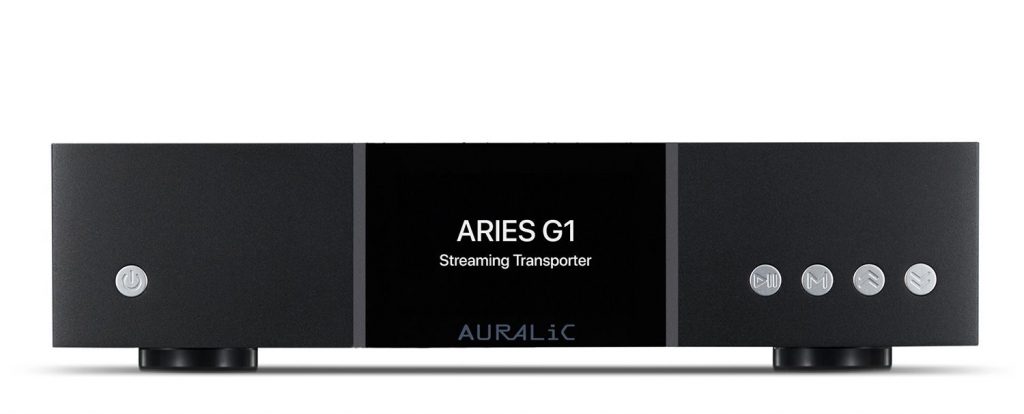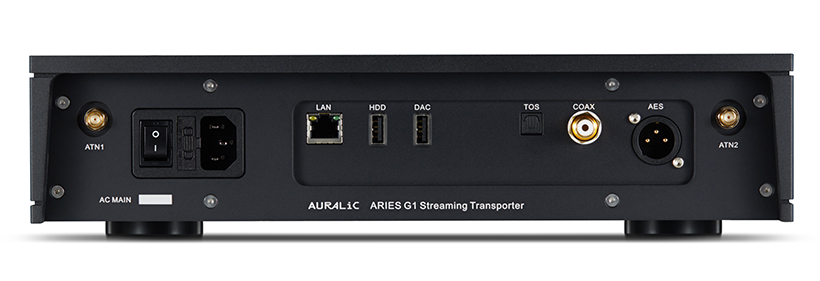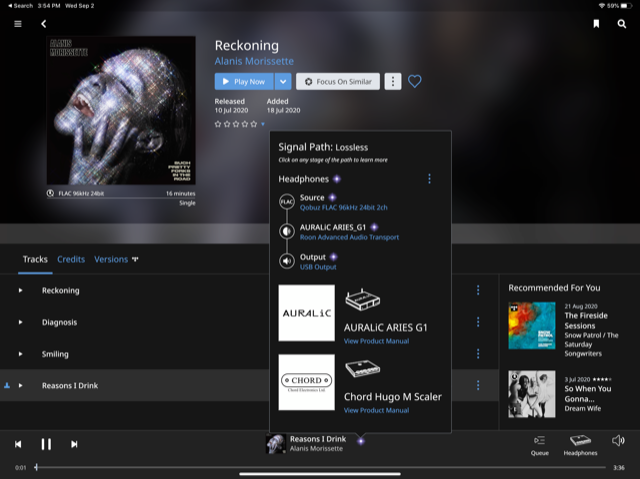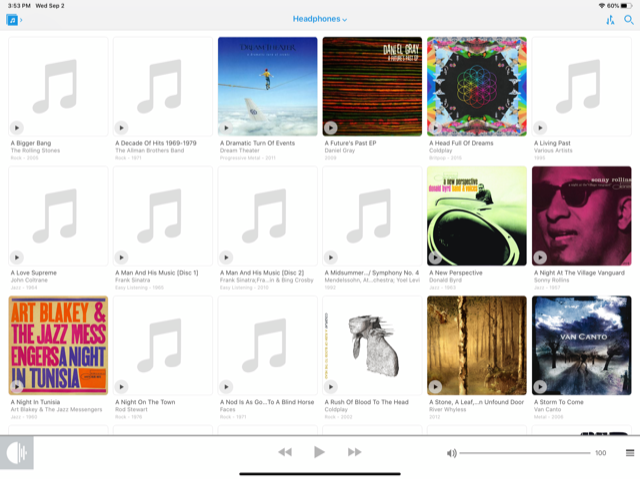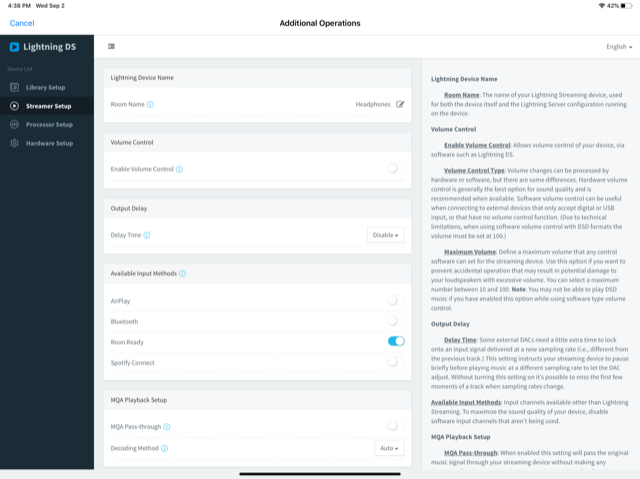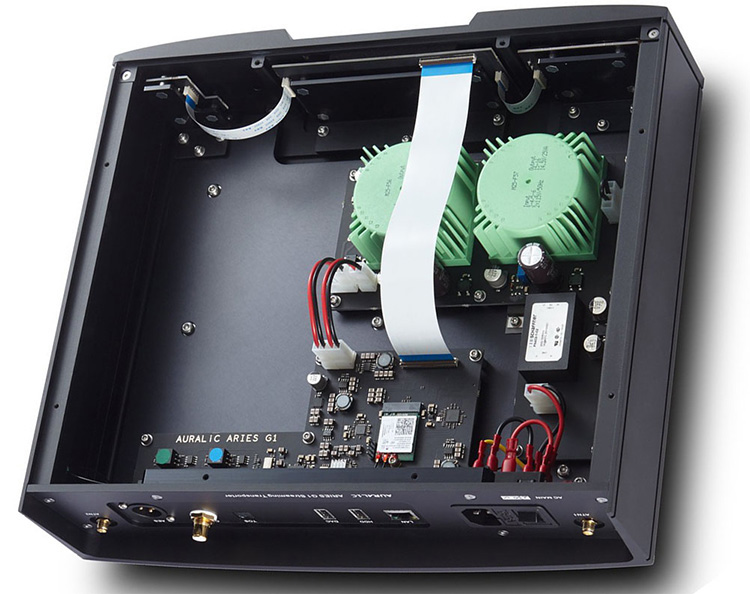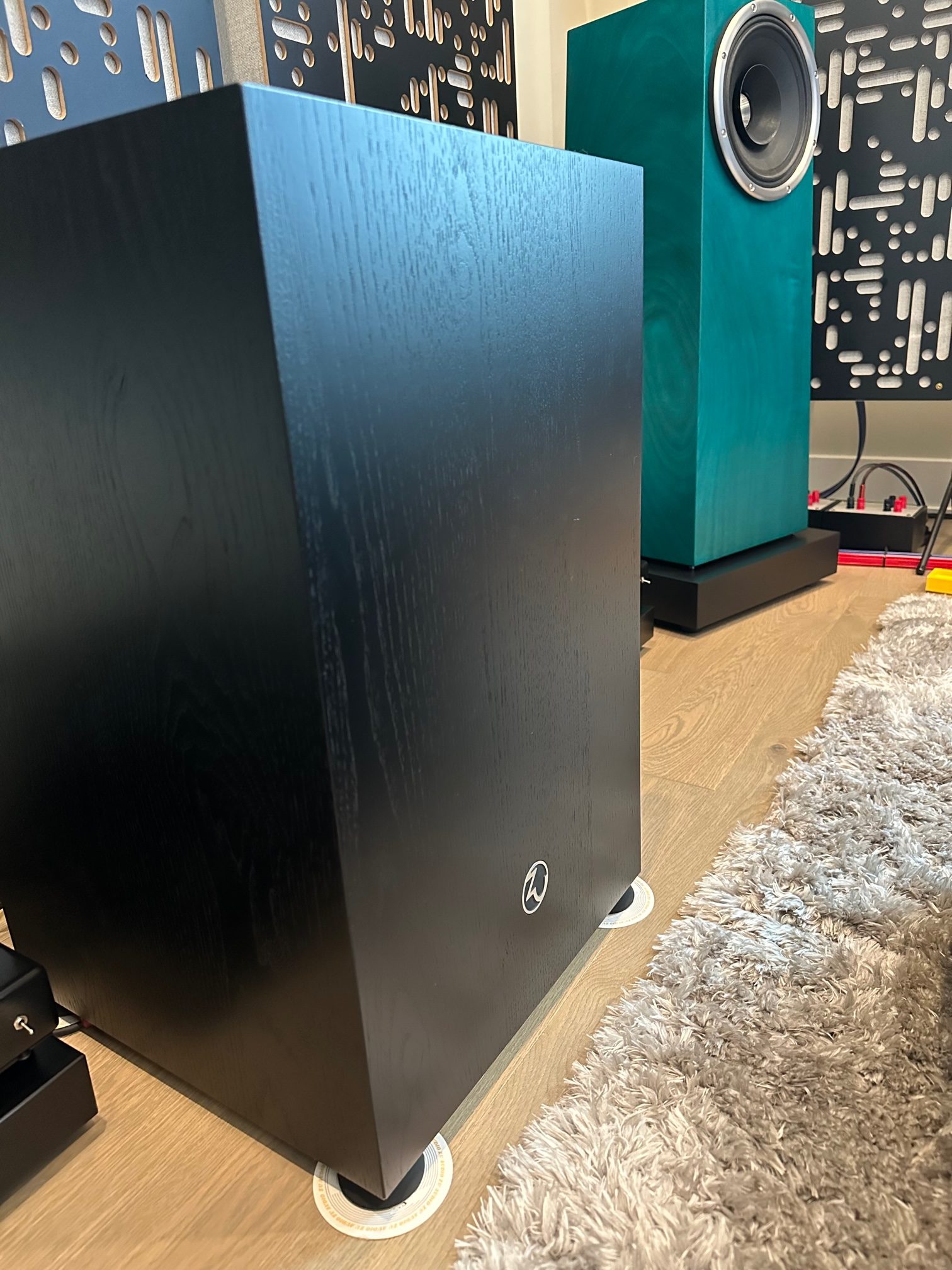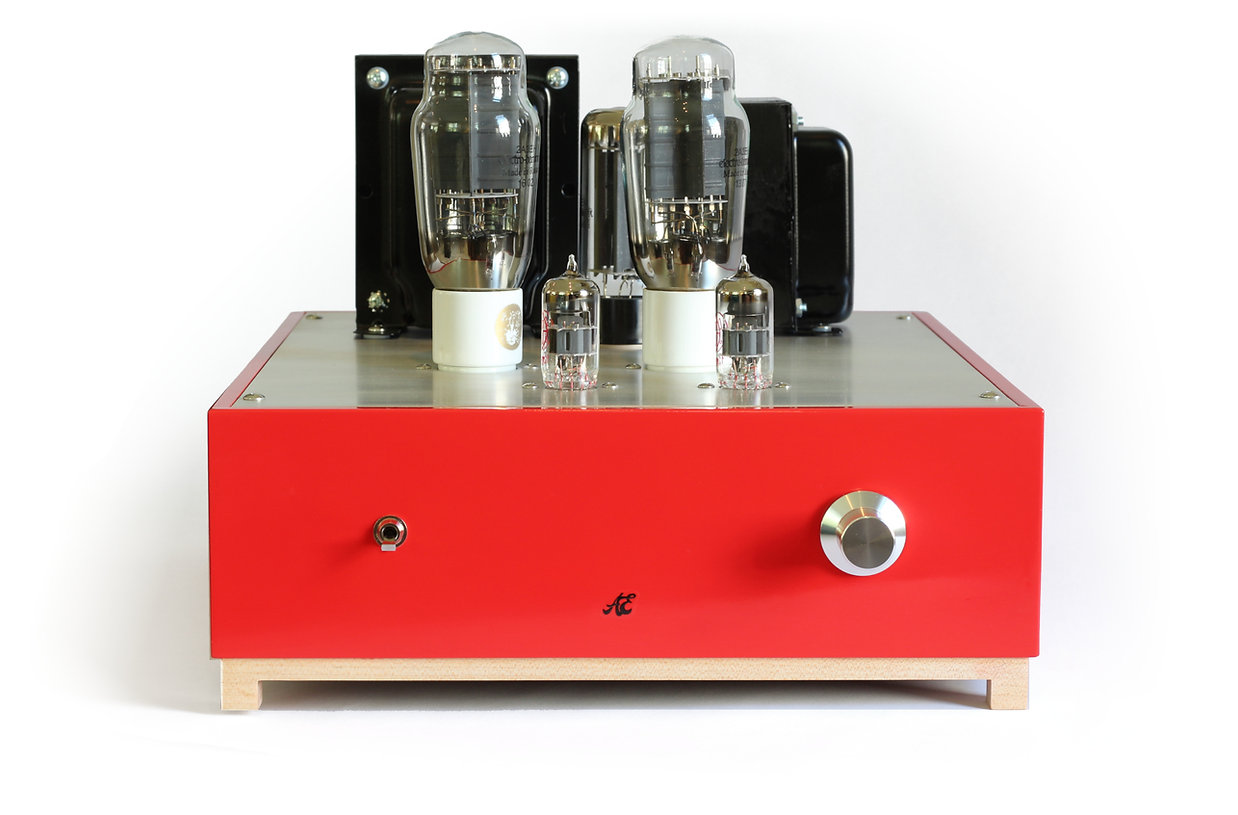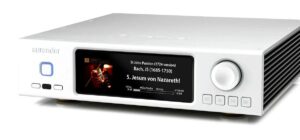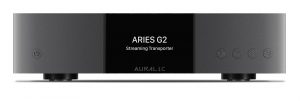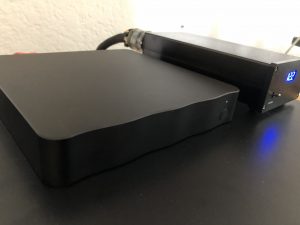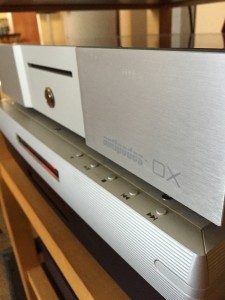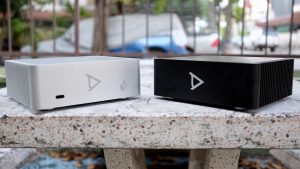When it comes to streamers, my point of view is simple: software is king. Good software can make a streamer, and bad software can break a streamer. For example, I have a streamer that sounds wonderful, however, it crashes at least once a listening session. For a time I tolerated these crashes, however, with no fix coming from the manufacturer, and the crashes becoming a consistent part of my audio experience, my frustration grew. As my frustration hit its peak the AURALiC Aries G1 arrived for review. The end to end experience with the Aries G1 was eye opening, and reminded me that it was okay to expect the same level of polish for audio software as I expect for audio hardware. To cut to the chase, the Aries G1 does everything right, with polish that extends to both its hardware and its software, and easily justifies its retail price. This is rare to see in the audio world, and the level of polish is even on the verge of being Apple/iPhone like.
Establishing the Basics
One question I get asked all the time is: what is a streamer? I like to think of a streamer as a remote S/PDIF or USB port that I can send digital music data to. That data can then be forwarded using the S/PDIF or USB port to my DAC. Generally, the music data arrives to the streamer using Ethernet, though some streamers, like the Aries G1, support WiFi. The music data itself generally comes from a server on the listener's network, or from a digital music service like Qobuz or Tidal.
Streamers are generally controlled by an app or web page that controls what music is being played. Roon support, while still not a given, is a key requirement given Roon's large install base amongst digital audiophiles.
For some, you may read the above and say "okay, so a streamer sounds like a computer, why shouldn't I just use my computer?" This is a great question, and one that took me a long time to understand the answer to.
General purpose computers like a Mac Mini or a Windows laptop are doing many different tasks at the same time. These tasks generate noise, just by the nature of how computers work. Depending upon the sensitivity of your downstream equipment, this noise can result in digital harshness, peaky treble, and a lack of base impact. A streamer attempts to solve this issue of noise by using lower-powered computer hardware that only does one task: it catches the audio file coming in from the Ethernet or WiFi interface, and then outputs that data to the DAC. Likewise, high end streamers like the Aries G1, apply caching, galvanic isolation, and re-clock the data before sending it to the DAC.
Whether or not you hear the difference made by a good streamer depends entirely on your downstream equipment. My ability to differentiate between streamers only started when I was using DACs that retailed for more than $2000, or when the DAC in question had a known deficiency on the USB input.
So what does a good streamer look like? A good streamer is built solidly. It has software that is polished and provides a native app for control. It has pre-built integrations with all the major music streaming services, and it has Roon integration. As far as connectivity goes, it provides a USB output, but also S/PDIF outputs, preferably at least optical and coaxial. Finally, it is reliable and does not require frequent restarts. Let's see how the Aries G1 measures up to that bar.
First Impressions with the Aries G1
The Aries G1 was not my first AURALiC product. For a while I owned the Vega G2, and always loved the look of the new G1 and G2 line. What I was not prepared for though, was the case work of the Aries G1. I had made the assumption that the case work would be a step down both in weight and overall fit and finish from the G2 line. Upon my initial unboxing, before I saw the silver buttons on the front (a key feature that easily distinguishes the G1 (silver) and G2 line (black)), I thought AURALiC had accidentally sent me a Aries G2. The case work is simply stunning. Each piece of the chassis fits perfectly together, the matte black finish is perfect, even though it does seem to love finger prints.
Every detail including labels clearly have a significant amount of thought on the Aries G1
Around the back, you have your standard power cord plug, balanced S/PIDF, Coaxial S/PDIF, Optical S/PDIF, and an isolated USB output meant for your DAC. You also have a USB port for connecting things like USB hard drives or CD drives. Finally, there are two antennas on the back, which provides WiFi Connectivity and the ability to connect Bluetooth audio sources.
Looking at the front of the device, you have a color Retina display which provides on device access to the menus, settings, what is playing, and the music library. You have 4 buttons: menu, play/pause, up, and down.
The Aries G1 does not ship with a remote control, however, the Aries G1 can learn button presses from any remote, and you can assign those button presses to a specific function. I will say, I would have liked to see a bundled remote, preferably a silver Apple remote, but nothing stops me from pulling an old silver Apple remote out of storage and programming it to work with the Aries G1.
Completing the initial setup was incredibly simple. I started by plugging the Aries G1 into my DAC via USB, I plugged in my Ethernet cable, and connected the unit to power. The Aries G1's display lit up, and gave me a progress bar. Once it had completely booted, it showed its IP address on the screen.
I then downloaded the Lightning DS app, which is IOS only, onto my iPad. The app immediately found the Aries G1, and within a few clicks the unit was registered and completely setup.
Switching to Roon; Roon immediately discovered the Aries G1, and all I had to do was enable it. Roon also properly auto discovered the right setting for the connected Chord M Scaler. Once set up, I chose a song and pressed play, and the album artwork lit up on the Aries G1's display. Setup really was that easy, and I could not help but laugh a little bit at just how polished the setup process was compared to some of the other competitors out there.
Switching back to Lightning DS on the iPad, I linked my Qobuz, Tidal, and Spotify accounts, and checked to make sure I could stream from each of them. I also enabled airplay, and tested airplay-ing some content from my phone to the Aries G1. All worked perfectly and as expected.
Review System
For this review I used the Aries G1 in a few different ways:
- As a Roon Endpoint, streaming to my Chord M Scaler via USB.
- As a Roon Endpoint, streaming to my Chord M Scaler via Coaxial SPDIF.
- As a Lightning DS server/renderer with both USB and Coaxial SPDIF.
- As a CD Player using the new Lightning DS CD playback functionality.
In all cases the Aries G1 was in a system consisting of the following:
- Custom Built Roon Core
- Chord Dave and Chord M Scaler
- ampsandsound Nautilus headphone amplifier
- PS Audio P12 Power Regenerator
- Core Power Deep=Core
- Hifiman Susvara, ZMF Verite Closed
- Power Cables: Wireworld Stratus and Electra
- Analog Interconnects: Wywires Platinum RCA Cables
- Digital Interconnects: FTA Callisto USB Cable, WAVE BNC Cables
- External USB CD Drive
Let's Talk about Software
Lightning DS is simple to use, and fast
In my mind, what makes AURALiC stand out from the competition is their software polish. Lightning DS is simply a well-built piece of software. The iOS apps work well, it does not loose connection, and the Aries G1 was always responsive during my testing. Even the menus on the device were extremely clear, with an explanation of what each setting did appearing on the right hand side of the screen on the Aries G1 built-in display.
This level of polish also extended to the web interface, where once again each setting had an explanation for what it was and what it did.
Web Interface for advanced configuration
One thing that is nice about the Aries G1 is that it can be its own Server/Streamer. Setting up a music library with Lightning DS was as simple as setting up the Aries G1. From the IOS app all I had to do was add a music store. This music store could be a hard drive connected via USB on the back of the Aries G1, or a folder shared on your local network. Once the Aries G1 had a music source, it simply synced the music's metadata, and pulled metadata down from the internet where possible.
This brings me to my only gripe with Lightning DS, there is not a built in way to fix incorrect album titles, combine multi-disk albums, or in generally manage your library's metadata. When speaking with AURALiC I learned that this was by design. They did not want Lightning DS to make any changes to your library. When I asked about their suggested process for fixing album artwork issues and other metadata related issues, they suggested I use an audio metadata editor to update the metadata appropriately, and then reload the songs into Lightning DS. There is nothing wrong with this approach, however, one of the reasons I like software like Roon and iTunes is that they both make it easy to update and fix these issues in the user interface as you find the problems.
One of the selling points of the Aries G1, is its massive 1 gigabyte cache for music files. By loading the music into the massive memory cache the Aries G1 can then re-clock the data before passing it out via USB or the S/PIDF interfaces. The goal of this process is to remove as much jitter as possible.
With the latest version of Lightning DS, AURALiC introduced the ability to attach a USB CD drive to the Aries G1 (or any version of the Aries and Altair G1), and either rip CDs or play them directly from the drive. I tested out the latter use case, and it worked incredibly well. One reason it works so well is AURALiC loads the track from the CD into the memory cache and then outputs it to the DAC, just like with digital files. This removes jitter and makes the quality of the actual CD drive used much less important. This addition to the G1 is simply awesome, and I think the fact that AURALiC is adding net new features to their product line years after launch is incredible, and something I wish other companies would take note of. Similarly, as audio consumers we should expect that companies support, maintain, and enhance their software for years given the cost of some of this equipment. In practice AURALiC seems to be one of the few who actually deliver on this expectation.
That is not the end of the versatility when it comes to the Software on the Aries G1. It also supports parametric EQ filters, speaker placement compensation, and digital volume control. While digital volume control is a convenience feature, the other two features are incredibly important for speaker systems. While I use the Aries G1 in my high-end headphone system, the value of these features cannot be overstated in a traditional speaker system, and make the Aries G1 even more versatile.
As I have reviewed this unit, I have had some people ask me: "Well why does the software on the Aries G1 really matter? You use Roon in your day to day life, won't most people use Roon as well?" While that may be true for me, there are two things that are wrong with that train of thought. The first thing to remember is that Roon is a third party. Nothing stops them from going out of business or discontinuing their service. The second thing to keep in mind is that some people don't want to pay $125 a year for a Roon membership, and when you are buying a device as expensive as the Aries G1, there should be an included alternative. The thing I like about the Aries G1, is that if I did not want to pay for Roon or if Roon went out of business tomorrow, I would not feel stuck, and Lightning DS is an excellent included alternative.
The last thing to point out around software is that the Aries G1 does support the OpenHome protocol in addition to Roon and Lighting DS. I tested this using the Lynn Kazoo app and found that the Aries G1 responded quickly, and worked as I would expect. There are some limitations when using the OpenHome however, if you plan to buy this device as a OpenHome endpoint, I think there are other alternatives to consider. Simply put, use Lightning DS or Roon with the Aries G1, you will be happier.
Sound Quality
Can a streamer really affect sound quality? Some who read this article will argue no, digital is digital, bits are bits, and it either works or it does not. Those who argue that probably don't realize that USB audio does not employ error checking and bit correction (as there is not time to wait for a retry), and probably do not think about noise that can travel down your cables into your DAC.
AURALiC is very upfront on what the Aries G1 does. When talking to Alex Brinkman, he said, "Our goal with the Aries G1 is to reduce electrical noise. We have done everything in our power to make it as quiet as possible." I appreciated the honesty in this answer, with digital devices there is only so much you can do. You can cache the files to reduce jitter, which is what AURALiC does, and you can reduce electrical noise and isolate the outputs as much as possible so as to not pass that noise down to your DAC.
So how effective was AURALiC's noise reduction? To figure this out I performed an experiment. I own a pair of headphones that are 104dB/mW efficient. The end result is that on my headphone amp, I can hear the line noise from my DAC when the amp is left wide open. I used my Mini DSP headphone measurement jig to measure the resulting noise with my previous streamer in the circuit and the AURALiC Aries G1. The results were substantial, and the difference was so large that I am not going to publish the exact figure as most probably would not believe it. However, the difference in noise floor was a quarter turn on my passive preamplifiers volume control.
The result of this reduced noise in my system was revolutionary. Soundstages exploded on my Hifiman Susvara, from a kind of out of my head experience sometimes, to a full out of my head experience all the time. I found myself closing my eyes and pointing to singers, guitars, and drums, everything was simply locked in place. Micro-detail improved as well, little reverberations were easily heard and the decay of notes became sharper and more focused.
As I prepared to write this review, I went to look at what others have said about the Aries G1 in the past. One common comment was that Roon playback sounded slightly worse then Lightning DS. In my research I had read that AURALiC had addressed this in version 6 of the Aries G1 firmware. As a result I spent a significant amount of time going back and forth between streaming music from Roon and streaming music from Lightning DS to see if I could tell the difference. The answer was simply no, no matter how I streamed the music to the Aries G1, the result was the same, stunning detailed music that flowed organically. Normally, at this point I would choose a few songs and talk about how the Aries G1 improved the experience, but it improved every song. It improved every experience, it simply made my system sound better than it ever had, and to me this is a much more powerful statement then how it enhanced "Mira" by Melody Gardot.
The next thing I want to talk about is WiFi. There are many streamers out there that offer WiFi, however, for most there will be a downgrade in performance. This is mostly due to the fact that WiFi is noisy. AURALiC has worked really hard to make WiFi as quiet as possible, and they even recommend connecting the Aries via WiFi, as an Ethernet cord is just another way to introduce noise into your system. In my testing I was not able to tell the difference between WiFi and Ethernet. Switching back and forth was not noticeable, and the Aries continued to be just as responsive. Ultimately, I connected the Aries via Ethernet because I just prefer hardwired connections, however, I am happy to know that when I move I won't need to be hardwired in my audio room. I also think the fact that AURALiC achieved this level of stability on WiFi is quite amazing.
The final thing to touch on is that I have tried all outputs except the balanced S/PIDF and they are all excellent. After a lot of testing on my system, I found that I preferred the USB out, which seemed to be slightly smoother. One thing that I found odd was that you had to choose if the Aries G1 would output via the S/PDIF outs, or via the USB. It is not possible to run both outputs in parallel. This is not the end of the world, but there are situations that I would really have liked to have both outputs running at the same time.
What's Not to Like?
So is there anything that I would change? I would love for Lightning DS to be able to be the base of my home streaming system. However, it cannot be, the Lightning DS app does not control other non-AURALiC devices, and that means if I want to use Lightning DS to power my in ceiling speakers, or provide streaming music to my family room, I am stuck with choosing between an AURALiC Altair G1, Aries G1, and a Vega G1. To be clear these are all excellent devices, but they all cost over $2000 and provide way more fidelity then I need in any of the above use cases. This forces me to use Roon as a back-end, which is slightly disappointing. AURALiC used to have the Aries Mini, and I would personally love if they would bring it back to handle the lower fidelity use cases and needs, as it would really allow someone like me to build an entire home system on top of Lightning DS.
My only other complaint is the inability to fully mange and edit metadata in your music library from within Lightning DS. Again, this is not a big deal but something that I feel is missing given how polished everything else is.
Finally, I do hope that the next revision of the Aries includes Bluetooth output. With the rise in popularity of Apt-X and other high res Bluetooth audio formats, and companies like Hifiman making excellent Bluetooth headphones such as the Ananda BT, it feels like a natural extension of a streamer's capabilities. For example, the Bluesound Node 2i has this capability, and so does the NAD M10. Honestly, I would love if AURALiC would update the software and provide a USB stick that could be plugged into the back the Aries G1. Who knows? Maybe they will add this feature in the future.
Concluding Thoughts
The Aries G1 was a revolution for my system. I am keeping it, and I called Alex two weeks after it arrived to inform him that I did not want to send it back. The improvements it made to my system were obvious from the moment I clicked play. Outside of its playback performance, it offered stable software, incredible design, and an excellent presentation. Seeing the difference it made in low level noise in my system simply sealed the deal and explained some of the audible improvement I heard.
The Aries G1 is not cheap, so recommendations on buying one of these needs to be taken with a grain of salt. In my system, which retails for north of $30k, the Aries G1 is a no brainer. Would I buy one for a system that retails for $2k? No, but at $5k and up, and if digital is the centerpiece of your system, you are doing yourself a disservice by not auditioning the Aries G1.
I also have no issue recommending any of the other streaming enabled AURALiC products. I owned the Vega G2, and think it is one of the best DACs you can buy, and it has a built in streamer (though the built in streamer really does not sound as good as the Aries G1). The Vega G1 and Altair G1 share the same endorsement, while I have not spent as much time with them, I have heard enough, and have had enough experience with AURALiC products that I am very comfortable recommending them.
Polish, software, and beautiful case work is what you get with the Aries G1. I bought one, and before you say a streamer does not matter, I encourage you to try this one. Just be careful, you will probably buy it after having it in your system for a few days.
Thank you Alex and the AURALiC team for allowing me to review the Aries G1, it is exceptional and I look forward to see what you have in store for us next.
Aries G1
Retail: $2699
AURALiC




